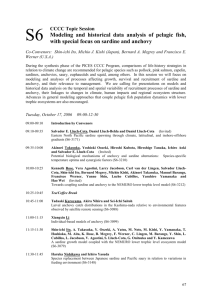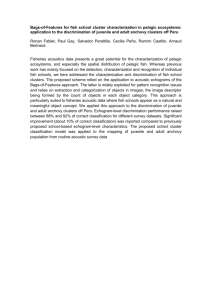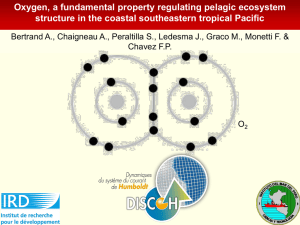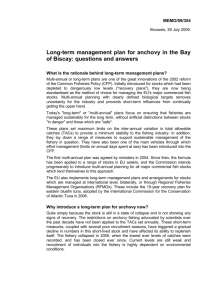doc - PICES - North Pacific Marine Science Organization
advertisement
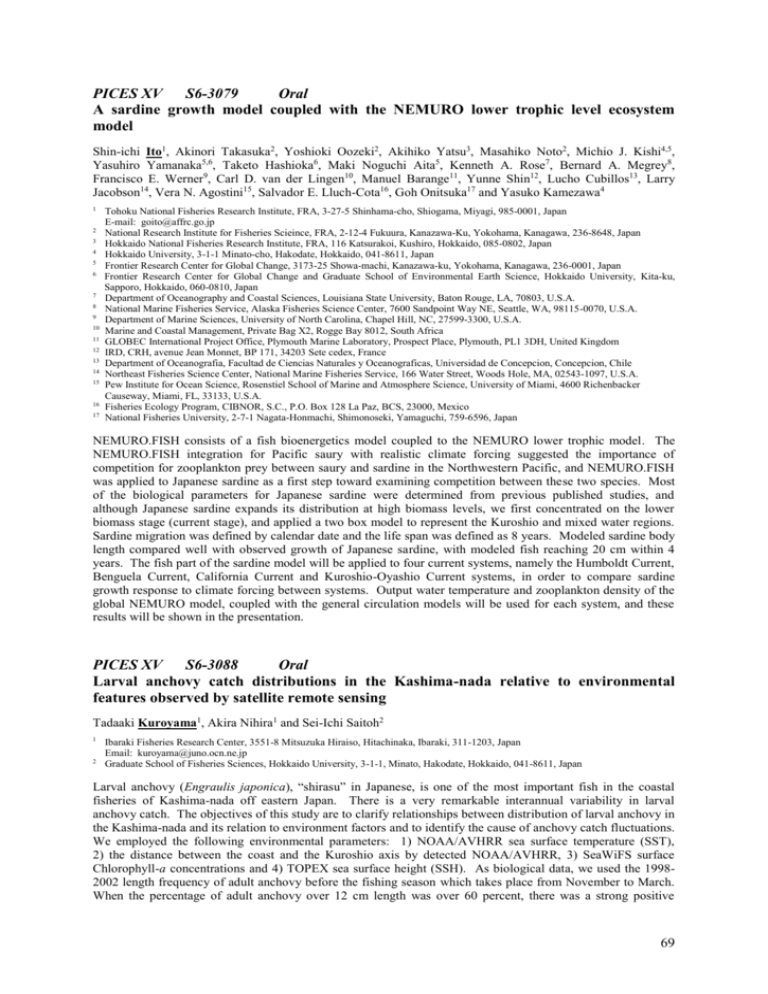
PICES XV S6-3079 Oral A sardine growth model coupled with the NEMURO lower trophic level ecosystem model Shin-ichi Ito1, Akinori Takasuka2, Yoshioki Oozeki2, Akihiko Yatsu3, Masahiko Noto2, Michio J. Kishi4,5, Yasuhiro Yamanaka5,6, Taketo Hashioka6, Maki Noguchi Aita5, Kenneth A. Rose7, Bernard A. Megrey8, Francisco E. Werner9, Carl D. van der Lingen10, Manuel Barange11, Yunne Shin12, Lucho Cubillos13, Larry Jacobson14, Vera N. Agostini15, Salvador E. Lluch-Cota16, Goh Onitsuka17 and Yasuko Kamezawa4 1 2 3 4 5 6 7 8 9 10 11 12 13 14 15 16 17 Tohoku National Fisheries Research Institute, FRA, 3-27-5 Shinhama-cho, Shiogama, Miyagi, 985-0001, Japan E-mail: goito@affrc.go.jp National Research Institute for Fisheries Scieince, FRA, 2-12-4 Fukuura, Kanazawa-Ku, Yokohama, Kanagawa, 236-8648, Japan Hokkaido National Fisheries Research Institute, FRA, 116 Katsurakoi, Kushiro, Hokkaido, 085-0802, Japan Hokkaido University, 3-1-1 Minato-cho, Hakodate, Hokkaido, 041-8611, Japan Frontier Research Center for Global Change, 3173-25 Showa-machi, Kanazawa-ku, Yokohama, Kanagawa, 236-0001, Japan Frontier Research Center for Global Change and Graduate School of Environmental Earth Science, Hokkaido University, Kita-ku, Sapporo, Hokkaido, 060-0810, Japan Department of Oceanography and Coastal Sciences, Louisiana State University, Baton Rouge, LA, 70803, U.S.A. National Marine Fisheries Service, Alaska Fisheries Science Center, 7600 Sandpoint Way NE, Seattle, WA, 98115-0070, U.S.A. Department of Marine Sciences, University of North Carolina, Chapel Hill, NC, 27599-3300, U.S.A. Marine and Coastal Management, Private Bag X2, Rogge Bay 8012, South Africa GLOBEC International Project Office, Plymouth Marine Laboratory, Prospect Place, Plymouth, PL1 3DH, United Kingdom IRD, CRH, avenue Jean Monnet, BP 171, 34203 Sete cedex, France Department of Oceanografia, Facultad de Ciencias Naturales y Oceanograficas, Universidad de Concepcion, Concepcion, Chile Northeast Fisheries Science Center, National Marine Fisheries Service, 166 Water Street, Woods Hole, MA, 02543-1097, U.S.A. Pew Institute for Ocean Science, Rosenstiel School of Marine and Atmosphere Science, University of Miami, 4600 Richenbacker Causeway, Miami, FL, 33133, U.S.A. Fisheries Ecology Program, CIBNOR, S.C., P.O. Box 128 La Paz, BCS, 23000, Mexico National Fisheries University, 2-7-1 Nagata-Honmachi, Shimonoseki, Yamaguchi, 759-6596, Japan NEMURO.FISH consists of a fish bioenergetics model coupled to the NEMURO lower trophic model. The NEMURO.FISH integration for Pacific saury with realistic climate forcing suggested the importance of competition for zooplankton prey between saury and sardine in the Northwestern Pacific, and NEMURO.FISH was applied to Japanese sardine as a first step toward examining competition between these two species. Most of the biological parameters for Japanese sardine were determined from previous published studies, and although Japanese sardine expands its distribution at high biomass levels, we first concentrated on the lower biomass stage (current stage), and applied a two box model to represent the Kuroshio and mixed water regions. Sardine migration was defined by calendar date and the life span was defined as 8 years. Modeled sardine body length compared well with observed growth of Japanese sardine, with modeled fish reaching 20 cm within 4 years. The fish part of the sardine model will be applied to four current systems, namely the Humboldt Current, Benguela Current, California Current and Kuroshio-Oyashio Current systems, in order to compare sardine growth response to climate forcing between systems. Output water temperature and zooplankton density of the global NEMURO model, coupled with the general circulation models will be used for each system, and these results will be shown in the presentation. PICES XV S6-3088 Oral Larval anchovy catch distributions in the Kashima-nada relative to environmental features observed by satellite remote sensing Tadaaki Kuroyama1, Akira Nihira1 and Sei-Ichi Saitoh2 1 2 Ibaraki Fisheries Research Center, 3551-8 Mitsuzuka Hiraiso, Hitachinaka, Ibaraki, 311-1203, Japan Email: kuroyama@juno.ocn.ne.jp Graduate School of Fisheries Sciences, Hokkaido University, 3-1-1, Minato, Hakodate, Hokkaido, 041-8611, Japan Larval anchovy (Engraulis japonica), “shirasu” in Japanese, is one of the most important fish in the coastal fisheries of Kashima-nada off eastern Japan. There is a very remarkable interannual variability in larval anchovy catch. The objectives of this study are to clarify relationships between distribution of larval anchovy in the Kashima-nada and its relation to environment factors and to identify the cause of anchovy catch fluctuations. We employed the following environmental parameters: 1) NOAA/AVHRR sea surface temperature (SST), 2) the distance between the coast and the Kuroshio axis by detected NOAA/AVHRR, 3) SeaWiFS surface Chlorophyll-a concentrations and 4) TOPEX sea surface height (SSH). As biological data, we used the 19982002 length frequency of adult anchovy before the fishing season which takes place from November to March. When the percentage of adult anchovy over 12 cm length was over 60 percent, there was a strong positive 69 relationship between catch and SST and weak positive correlation otherwise. This suggests that there is a possibility to predict larval anchovy catch using length composition of adult anchovy and SST. When the Kuroshio axis moved north and intruded to the Kashima-nada coastal region, larval anchovy catch increased. Larval anchovy and eggs seem to be transported to the Kashima-nada coast by the Kuroshio and grew up with warm SST. When the Kuroshio axis moved to south, larval anchovy catch decreased. This suggests that the fluctuation of larval anchovy catch was affected by the position and behavior of the Kuroshio. PICES XV S6-3099 Oral Individual-based models of anchovy Xiangxin Li Institute of Physical Oceanography, College of Physical and Environmental Oceanography, Ocean University of China, 5 Yushan Road, Qingdao, 266003, PR China. E-mail: lixiangxin@ouc.edu.cn Anchovy in the East China Sea have nearly disappeared in recent years warranting an examination of processes that control the population. In this paper a model of anchovy is presented where we calculate phytoplankton and zooplankton densities on a two-dimensional grid as a background for the anchovy simulation. We used individual-based models (IBMs) to simulate the life history of anchovy. Two attributes of every individual anchovy (or egg) include genotype and phenotype. Individual activities include consumption, metabolism, movement, spawning, hatching and death. We assume an individual’s genotype remain constant over its lifetime. The genotypes of eggs are inherited from their parents and little aberrance is considered in the model. Phenotype is time variable. Genotype and environment co-determine an individual’s activities and then determines the future phenotype. There are two phases considered in this model. The aim of first phase is to train the each individual’s genotype. In this phase, the mechanisms of the death were divided into three types, including forced death, natural death and death because of starvation. Abnormal individuals are forced to die, which means forced death. In the second phases, trained individuals are placed in a changing environment. The response of entire ecosystem is then simulated to determine the influence of environment changes. PICES XV S6-3171 Invited Eastern North Pacific sardine spawning through climate, latitudinal, and inshoreoffshore gradients Salvador E. Lluch-Cota1, Daniel Lluch-Belda2 and Daniel Lluch-Cota1 1 2 Centro de Investigaciones Biológicas del Noroeste, S.C. (CIBNOR), P.O. Box 128, La Paz, Baja California Sur, 23000, Mexico E-mail: slluch@cibnor.mx Centro Interdisciplinario de Ciencias Marinas del IPN (CICIMAR), Av. Instituto Politécnico Nacional s/n., Col. Playa Palo de Santa Rita, P.O. Box 592, La Paz, Baja California Sur, 23096, Mexico Historical data analyses and comparison of sardine and anchovy catch records from different regions of the world have resulted in the notion of synchrony occurring between remote systems, independently of the effect of fishing pressure and management strategies, and the oceanographic domain and local forcing. It has been proposed that mechanisms underlying abundance changes must be simple and controlled by the same background climate signal. In contrast we have faced several rejected or inconclusive hypotheses, and a failure of integration attempts. In this contribution we provide a brief review of some of these drawbacks, and identify a common problem in the lack of historical information. We realize modeling represents an alternative to test some of the main existing hypotheses. Based on studies of the eastern North Pacific sardine, we discuss: 1) the differences and changing rates in the spawning intensity (eggs and larvae abundance) and physical conditions between climate regimes, latitudinal, and inshore-offshore gradients, 2) a simple model that expresses advection of early stage individuals as a function of spawning ground location and temperature-dependent growth, and 3) climate scenarios proposed to be tested and compared using models and data analyses, after reviewing traditional criteria and definitions. 70 PICES XV S6-3148 Oral Species replacement between Japanese sardine and Pacific saury in relation to variations in feeding environment Haruka Nishikawa and Ichiro Yasuda Ocean Research Institute, The University of Tokyo, 1-15-1, Minamidai, Nakano-Ku, Tokyo 164-8639, Japan E-mail: harukan@ori.u-tokyo.ac.jp In the 1980s, the dominant species of small pelagic fishes in the Northwestern Pacific was the Japanese sardine (Sardinops melanostictus). But the population decreased from 1988. On the other hand, Pacific saury (Cololabis saira) increased from 1988 and exceeded Japanese sardine in 1997 in terms of catches. Population fluctuations of Japanese sardine have been suggested to be related to winter sea surface temperature variations in the Kuroshio Extension (Noto and Yasuda, 1999). Tian et al. (2002) reported that the fluctuation of largesize Pacific saury was correlated with winter sea surface temperature in the Kuroshio south of Japan. However, the cause of this species replacement coincided with the change of environment in the Kuroshio Extension, and thus remains unclear. Using the NEMURO model, we carried out numerical experiments to estimate the feeding environment of sardine and saury. From the results obtained, we suggest a hypothesis for the species replacement between Japanese sardine and Pacific saury as follows. Since 1988, the winter shallow mixed layer depth in the Kuroshio Extension has led to early phytoplankton blooms, and zooplankton populations have occurred earlier in the year. Consequently, winter zooplankton increased while spring zooplankton decreased. Pacific saury that grows in the Kuroshio Extension in winter can take advantage of the early blooms, but the Japanese sardines that migrate to the Kuroshio Extension in spring could not survive because of low food density. This match/mismatch with the bloom may explain the late 1980s species replacement from Japanese sardine to Pacific saury in the Northwestern Pacific. PICES XV S6-3212 Invited Towards coupling sardine and anchovy to the NEMURO lower trophic level model Kenneth A. Rose1, Vera N. Agostini2, Larry Jacobson3, Carl van der Lingen4, Salvador E. Lluch-Cota5, Shin-ichi Ito6, Bernard A. Megrey7, Michio J. Kishi8,9, Akinori Takasuka10, Manuel Barange11, Francisco E. Werner12, Yunne Shin13, Lucho Cubillos14, Yasuhiro Yamanaka9,15 and Hao Wei16 1 2 3 4 5 6 7 8 9 10 11 12 13 14 15 16 Department of Oceanography and Coastal Sciences, Louisiana State University, Baton Rouge, LA, 70803, U.S.A. E-mail: karose@lsu.edu Pew Institute for Ocean Science, Rosenstiel School of Marine and Atmosphere Science, University of Miami, 4600 Rickenbacker Causeway, Miami, FL, 33133, U.S.A. Northeast Fisheries Science Center, National Marine Fisheries Service, 166 Water Street, Woods Hole, MA, 02543-1097, U.S.A. Marine and Coastal Management, Private Bag X2 Rogge Bay 8012, South Africa Fisheries Ecology Program, CIBNOR, S.C., P.O. Box 128, La Paz, BCS, 23000, Mexico Tohoku National Fisheries Research Institute, FRA, 3-27-5 Shinhama-cho, Shiogama, Miyagi, 985-0001, Japan National Marine Fisheries Service, Alaska Fisheries Science Center, 7600 Sandpoint Way NE, Seattle, WA, 98115-0070, U.S.A. Hokkaido University, 3-1-1 Minato-cho, Hakodate, Hokkaido, 041-8611, Japan Frontier Research Center for Global Change, 3173-25 Showa-machi, Kanazawa-ku, Yokohama, Kanagawa, 236-0001, Japan National Research Institute for Fisheries Science, FRA, 2-12-4 Fukuura, Kanazawa-Ku, Yokohama, Kanagawa, 236-8648, Japan GLOBEC International Project Office, Plymouth Marine laboratory, Prospect Place, Plymouth, PL1 3DH, United Kingdom Department of Marine Sciences, University of North Carolina, Chapel Hill, NC, 27599-3300, U.S.A. IRD, CRH, avenue Jean Monnet, BP 171, 34203 Sete cedex, France Department of Oceanography, University of Concepción, P.O. Box 160-C, Concepción, Chile Frontier Research Center for Global Change and Graduate School of Environmental Earth Science, Hokkaido University, N10W5, Kita-ku, Sapporo, Hokkaido, 060-0810, Japan Physical Oceanography Lab, Ocean University of China, 5 Yushan Road, Qingdao, 266003, PR China Sardines and anchovies exhibit classic population cycles whose interpretation seems to get more complicated with each new examination. The NEMURO model has been developed by an international group of scientists as a template NPZ lower trophic model for regional comparisons. Single species bioenergetics models for herring and saury have been coupled to NEMURO and are known as NEMURO.FISH. This presentation describes the next step in the evolution of the NEMURO.FISH coupled modeling approach – namely the simulation of Sardine and ANchovy population dynamics (NEMURO.SAN). We first describe the general 2-dimensional framework of NEMURO.SAN, and how we use an individual-based approach for simulating the daily growth, mortality, reproduction, and movement of sardines and anchovy. Fish growth is based upon bioenergetics, with fish daily consumption dependent on the zooplankton and phytoplankton concentrations generated by NEMURO in each spatial cell. Fish consumption, in turn, is treated as an explicit mortality term on the plankton. By making mixed layer depth, nutrients, and other inputs to NEMURO specific to each model grid 71 cell, we can simulate spatial heterogeneity in fish habitat. Alternative hypotheses about climate conditions can be specified via changing the inputs to NEMURO, and the response of the anchovy and sardines predicted in terms of their growth, survival, and spatial distribution. Progress to date includes initial synthesis of available data for target locations, outlining of the general modeling framework, and the development of an initial computer code. We will present some preliminary multidecadal simulations that illustrate the general approach. Our goal is to next apply the NEMURO.SAN model to several locations, beginning with the California Current ecosystem. PICES XV S6-3074 Oral A two-dimensional fish model for simulating the biomass of Pacific saury Fumitake Shido1, Yasuhiro Yamanaka1,2, Shin-ichi Ito3, Taketo Hashioka1, Daiki Mukai1 and Michio J. Kishi1,2 1 2 3 Graduate School of Environmental Science, Hokkaido University, N10W5, Kita-ku, Sapporo, 060-0810, Japan E-Mail; Shido@ees.hokudai.ac.jp Frontier Research Center for Global Change, 3173-25, Showa-machi, Kanazawa-ku, Yokohama, 236-0001, Japan Tohoku National Fisheries Institute, 3-27-5, Shinhama, Shiogama, Miyagi, 985-0001, Japan We developed a two-dimensional fish model for Pacific saury (Cololabis saira) and applied it to the western North Pacific. We used the PICES NEMURO.FISH model (Ito et al., 2004), current fields (Sakamoto et al., 2005), and zooplankton and temperature data predicted by 3D-NEMURO (Hashioka and Yamanaka, 2006). We assumed that saury hatch in southern Japan (near 32ºN, 138ºE) in February 1, are advected by Kuroshio and Kuroshio extension during their larvae or juvenile stage, then during summer migrate west against the current in the young or adult stages, and then from fall to winter they migrate back to their original spawning area during the adult stage. The model successfully simulated the observed wet weight of saury during two years: 70g in the first summer and 140g in the second summer. The observed seasonal migration geographical distributions are also simulated well. Saury migrates to the north by several different routes, mainly through regions far from Japan during spring, staying off Hokkaido Island during summer, and back the along coastal area off Honshu Island during the fall. An Eulerian method was adopted because we will include two-way coupling between fish and zooplankton and predict their future biomass PICES XV S6-3210 Invited Potential biological mechanisms of anchovy and sardine alternations: Species-specific temperature optima and synergistic factors Akinori Takasuka1, Yoshioki Oozeki1, Hiroshi Kubota1, Hiroshige Tanaka2, Ichiro Aoki2 and Salvador E. Lluch-Cota3 1 2 3 National Research Institute of Fisheries Science, Fisheries Research Agency, 2-12-4 Fukuura, Kanazawa, Yokohama, Kanagawa 2368648, Japan. E-mail: takasuka@affrc.go.jp Graduate School of Agricultural and Life Sciences, University of Tokyo, 1-1-1 Yayoi, Bunkyo, Tokyo, 113-8657, Japan Centro de Investigaciones Biológicas del Noroeste, P.O. Box 128, La Paz, Baja California Sur, 23000, Mexico Pelagic fish have exhibited cyclic population dynamics in complex marine ecosystems. However, biological processes have yet to be resolved to explain out-of-phase oscillations of anchovy and sardine and their synchrony/asynchrony among ecosystems. First, we explored simple and direct pathways to link climate changes and species alternations, focusing on species-specific temperature optimums. The initial idea was the “optimal growth temperature” hypothesis, based on differential optimal temperatures for larval growth rates of Japanese anchovy and sardine and temperature shifts between these values. To extend the theory and undertake a basin-scale comparison, spawning temperature optima of anchovy and sardine were examined using the longterm data set of egg and larval surveys. Contrasting spawning temperature optima of anchovy and sardine between opposite sides of the Pacific may provide a theoretical explanation to the synchronous alternations despite the reversed temperature regimes across the Pacific. In addition, spawning temperature optima reflected long-term population dynamics in terms of similarities and differences among anchovy, sardine, mackerel, and jack mackerel in the western North Pacific. Additional objectives include testing the generality of temperaturebased hypotheses and seeking synergistic mechanisms based on other factors. Comparisons of feeding habits among co-occurring small pelagics suggested that differential feeding strategies are unlikely to regulate dominance shifts but might lead to inter-species competition. Temporal and spatial overlaps of eggs and larvae were described as a potential source of competition between anchovy and sardine in the western North Pacific. A series of analyses provide biological parameters for models to predict the future trends. 72 PICES XV S6-3188 Oral Development of a lower trophic ecosystem model representing prey of juvenile pelagic fish in the subtropical western North Pacific Naoki Yoshie1 and Yasuhiro Yamanaka2,3 1 2 3 Tohoku National Fisheries Research Institute, Fisheries Research Agency, Shinhama-cho 3-27-5, Shiogama, 985-0001, Japan E-mail: nyoshie@affrc.go.jp Graduate School of Environmental Science, Hokkaido University, N10W5, Kita-Ku, Sapporo, 060-0810, Japan Ecosystem Change Research Program, Frontier Research Center for Global Change, 3173-25 Showa-machi, Kanazawa-Ku, Yokohama 236-0001, Japan The standing stocks of pelagic fish, anchovy and sardine, are affected by changes in climate through the direct link of physical process such as egg transport and/or the indirect link via dynamics of phytoplankton and zooplankton population’s abundance and distribution. The processes affecting survival of juvenile pelagic fish are important for interannual variations of standing stocks of adult fish. These processes are controlled by the prey conditions of the juvenile fish around the spawning grounds. In the western North Pacific, the spawning grounds are in the subtropical region near Japan. A lower trophic level marine ecosystem model, NEMURO (North Pacific Ecosystem Model Used for Regional Oceanography) developed by CCCC/MODEL task team does not include key groups of plankton in the subtropical region. In this study, we have extended NEMURO by introducing the subtropical groups of plankton (i.e., small-size phytoplankton, zooplankton, and bacteria), to simulate not only the subarctic but also the subtropical ecosystems. The extended NEMURO, eNEMURO, was applied to two stations A7 (41.5N, 145.5E) and B1 (30.0N, 138.0E) in the subarctic and subtropic western North Pacific. The eNEMURO model successfully simulated the seasonal changes in plankton biomass observed at the both stations, and those of the small size plankton at station. The eNEMURO results showed improved results compared to NEMURO. The fish growth model coupled with eNEMURO might be a useful tool for understanding the processes controlling the variations of fish standing stocks. PICES XV S6-3176 Oral Empirical modeling the stock fluctuations of sardine in the Japan/East Sea Yury I. Zuenko and Svetlana V. Davidova Pacific Research Fisheries Centre (TINRO-Centre), 4 Shevchenko Alley, Vladivostok, 690950, Russia. E-mail: zuenko@tinro.ru An empirical multiple regression model of the sardine stock in the Japan/East Sea is proposed: Sj = Σi=3,4,5,6…[Sj-i *(f +kNTN(j-i-1)+kWTW(j-i) +kSTS(j-i) +kCDC(j-i) +kDSj-i)*(1-m)i], where Sj is a stock for a j year, (f +kNTNj +kWTWj +kSTSj +kCDCj +kDSj) = F is a parameter of fecundity (taking into account the eggs and larvae survival), and m is a coefficient of fish mortality (constant, defined empirically). The fecundity depends on fish density and environmental conditions: f is a constant representing potential fecundity; kN, kW, kS, kC, kD are empirical coefficients; and the following environmental factors are considered as predictors: TN – SST on the feeding grounds (41-46oN) in spring-summer (negatively correlated with zooplankton abundance); TW – SST on the spawning grounds (35-38oN) in winter; TS – SST on the spawning grounds (35-38oN) in spring-summer (negatively correlated with zooplankton abundance); DC – the Cushing match/mismatch factor defined as sum of the deviation of winter and spring SST anomalies from an “ideal” correlation determined empirically. The component kDSj is a density factor and other components of F depend on environmental factors. According to D.H.Cushing’s hypothesis, the winter SST determines by physiological mechanisms the time of the larvae’s hatching, but the spring-summer SST determines the time of spring plankton bloom: a match of these terms is favorable for fish larvae survival and a mismatch is unfavorable. Long-time data series on the total catch of sardine in the Japan/East Sea by Japan, Korea and Russia (since 1917) and SST data since 1950 were used. Correlation of the catch of sardine with its stock was estimated using the data of trawl surveys in the Japanese EEZ in 1986-2003. The model describes 85% dispersion of the sardine catch in the period 1954-2003 and adequately simulates the stocks’ collapses in 1960s and 1990s and their rise in 1970-1980s. The most important environmental factors are the match/mismatch (kC = –1.37) and the feeding ground conditions (kN = –0.67). Excluding environmental factors from the model (i.e., transforming it to a simple reproduction density-dependent model) worsens it considerably to ~0.48 which is unsatisfactory for the stocks’ forecasting. Generally, lowered SST both in winter and spring-summer are favorable for sardine because of the higher plankton abundance in the feeding grounds 73 and coincides with the times of larvae hatching and plankton bloom. These conditions were observed in the late 1970s – early 1980s and is suggested as the reason for the prominent rise of the sardine stock. 74
